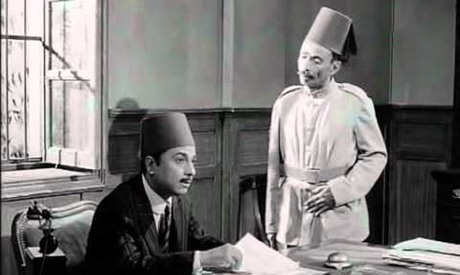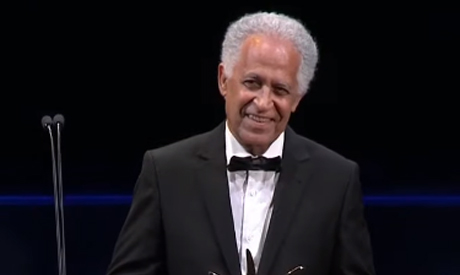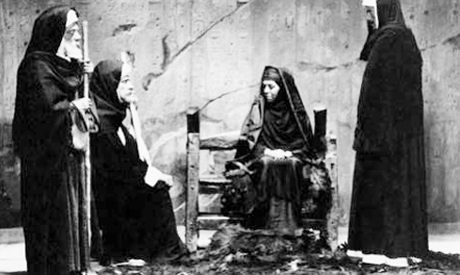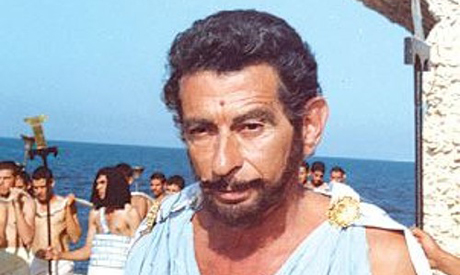Onsi Abou Seif is the art director of practically every important Egyptian film, he worked with the greatest filmmakers in the history of Egyptian cinema, but it takes seeing his free hand sketches to understand why.
I was lucky to have the opportunity to attend an exhibition on his work and life, which was held in tribute this year at El Gouna Film Festival (23-31 October. I was even luckier to meet the man himself, a talented risk taker and admirably modest coffee-lover who insisted on serving everyone himself even though he was the star.
Born in 1943 in Kom Ombo, Upper Egypt, Onsi Abou Seif remembers his childhood fondly: “At that time you could call the Upper Egyptian city cosmopolitan. It was famous for its sugarcane, presided over by Abboud Pasha, who also built a refinery there to produce sugar and so filled the city with houses of various architectural styles accommodating employees from different backgrounds."
"The city also had a cinema, so close to my house that I joined the club allowing me 30 films a month for a fixed fee and used to see a film every day. But it was so close that in summer, my friends and I would climb to the roof to listen. We always knew when the stars would start beating each other and when there would be a kiss. I had no idea I would ever work in the field.”

Diary of a Country Prosecutor
He had been studying at the Faculty of Fine Arts in Cairo when the Higher Institute of Cinema was founded. There were 70-100 students in his class, but the newly opened institute would have classes of seven-eight students. “So,” he says, “I applied for a transfer and enrolled there.”
His path had been clear from the start: “I loved drawing and I could do it well. That doesn’t necessarily mean I was an artist, but I had the technique down and that would help me a lot in my work.” By 1967 he had graduated from the institute, and within months he was assisting Salah Marie on the set of Shadi Abdel-Salam’s iconic classic The Night of Counting the Years (1969).

Abou Seif
“Salah Marie taught me everything about art direction and set design. My mission in that film was to create all the props and accessories starting from drawing the ancient Egyptians coffins to supervising all the sculpture work on set. This familiarised me with the art of the ancients, being Upper Egyptian I already had a passion for ancient Egypt, though I was shocked to see how little I actually knew compared to Shadi Abdel-Salam, who by pointing to a statue and saying a few words about beauty and faith could totally transform a young set designer."
"He had a huge influence on me, and to this day I feel blessed that I met him when I did – on my first job in cinema – and he made me part of his circle, which helped me enormously and in so many ways, though I still think of my work on The Night of Counting the Years as a formative experience, not my true beginning as an art director.”
Abou Seif regards his real beginning as Yawmiyat Naeib Fil Aryaf (Diary of a Country Prosecutor, 1969), based on Tawfik Al-Hakim’s eponymous 1937 novel. “In 1968, barely a year after my graduation,” he says, “the late filmmaker Tawfik Saleh had asked me to work with him. This was my true beginning, and it set the scene for my whole career. It was my first time dealing with real film studios and connecting with this great industry on the ground. Before that, I had just sat at the table drawing. Now I had to learn how to actually do things.” The blue-collar workers were his first teachers.

The Night of Counting the Years
“They were the heirs of a 100-year-old tradition, with the carpenter, for example, learning from his father, who in turned learned from his father. They know how to work with what’s available and real, not with theories about what should be there. This was very significant for me, seeing how a film is actually made. This was one thing. Another thing was that I had the good fortune to make my debut with someone as important as Tawfik Saleh.”
A strong beginning, it allowed him to be selective at an early age: “After working with Saleh, I felt I had to choose carefully. If the film was commercial and devoid of quality I’d say no. I felt if I did otherwise I’d be betraying a great man who gave me invaluable support and a push forward. So sometimes my choices were limited.”
In 1970 he won the first National Film Festival award for Mamdouh Shoukry’s Delusions of Love, in which he faced the unprecedented challenge of combining colour with black and white. He was able to be prolific, working with Rafaat Al-Mihi on Oyoun La Tanam (Eyes Never Sleep, 1981), for example, depicting a feud between two brothers fighting over their father’s workshop, which Abou Seif seamlessly created on two separate locations: a real space overlooking the 6 October Bridge, and a studio set that you could not tell apart on screen.

Return of a Citizen
“Of course I had successes and failures, but I’m proud of every film I made. What I mean by a failure is that it wasn’t appreciated or valued, but for me the point was that no film should look like the other. Every film I make is a unique experiment, and I think this comes through on screen. It also means I can learn not to repeat the failures. So I don’t see any one film as more important than another, though of course there is a film that is loved more, on which you spend more time and effort.”
Also in 1981, he worked with Ahmed Yehia on The Court Ruling and with Salah Abu Seif on Al-Qadisiya, the latter depicting the great Islamic battle in which the Arab general Saad Ibn Abi Waqqas defeated Persia. He also worked with Henry Barakat on Lailat Al-Qabd ala Fatma (The Night of Fatma’s Arrest, 1984), starring Faten Hamama and Shokry Sarhan, and with Samir Seif on Al-Halfout (The Nobody), starring Adel Imam, Elham Shahine and Said Saleh.
Abou Seif was the art director behind Youssef Chahine’s visually stunning Adieu Bonaparte (1985), set during the French Campaign (1798-1801). He was to work with Chahine again on Alexandria: Again and Forever (1990) and The Other (1999).
“Working with Chahine is a powerful experience, because the two of us would both be experimenting all the time. Two madmen, not just one. But it’s enriching because he’s not a traditional person and he will sacrifice anything for his work. He was the producer too, and he spared no amount of money or effort at all once he felt it was in the interest of the film – even if it meant cutting my pay in the process,” he laughs.

Alexandria: Again and Forever
After collaborating with Daoud Abdel-Sayed on his debut Al-Saalik (The Vagabonds, 1985), Abou Seif also worked with the director on his most popular film, Kit Kat (1991), the memorably poignant story of a blind man in a working-class neighbourhood starring Mahmoud Abdel-Aziz with Sherif Mounir, Amina Rizk, Aida Riyad and Najah Al-Mogi. It took Abdel-Sayed five years to find a producer for the film, Abou Seif recalls, partly because no one was willing to fund building a bespoke alleyway – until Chahine donated the alley that had been built for Adieu Bonaparte – and producer Hussein Al-Qalla repurposed it.
Abou Seif spent six months visiting Boulaq, a similar neighbourhood, on a daily basis to absorb the scene, and he won three honours for Kit Kat: the Film Association, National Festival and Alexandria Film Festival awards.
He also worked with Abdel-Sayed on Ard Al-Ahlam (Land of Dreams, 1993), Joy Stealer (1995), for which he received the National Festival, Film Society and Egyptian Society for the Art of Cinema awards, as well as Ard al-Khouf (Land of Fear, 2000), Rasael Al-Bahr (Messages from the Sea, 2010) and Qudrat Gheir Adeiya (Extraordinary Abilities, 2015).
In 1988 Abou Seif worked with both Khairy Beshara on Youm Mor wi Youm Hilw (A Bitter Day, A Sweet Day) and Mohamed Khan on Zawget Ragol Mohem (The Wife of an Important Man), the latter with Ahmed Zaki and Mervat Amin. Later in the same year he also made Ahlam Hind wi Camilia (Dreams of Hind and Camilia) with Khan, with whom he first collaborated on Awdet Mowaten (Return of a Citizen) in 1986.
He worked with Yousry Nasrallah on his debut Sariqat Sayfiya (Summersaults, 1988) and his second feature Mercedes (1993). Through all this Abou Seif witnessed the industry radically transform.
“I’m not an expert on the new technologies, my ultimate passion is to grab a pencil and make a sketch, and when I draw a line I don’t like, I go back and draw it again. Till now I didn’t use a device to make my designs. But in the field of the materials, there has been a huge development that allows us to be more braver with our set designs. I even built a model of Al-Muqattam hills, since it was possible."
"The old designs were more stunning because there was always a question of how it was possible to create them with such limited materials. There were always obstacles on the set, but I would found solutions. I eventually realised these solutions would never have occurred to me had I not faced the obstacles...”
*A version of this article appears in print in the 5 November, 2020 edition of Al-Ahram Weekly
Short link: